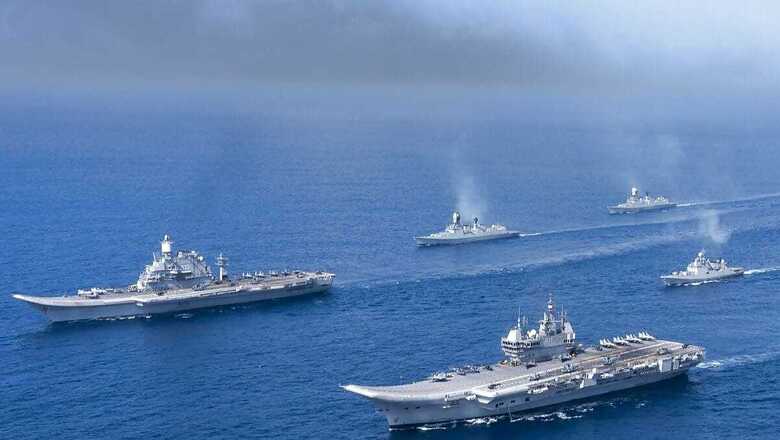
views
World Witnesses the Might of Indian Navy
The United States and its Western allies are caught up in the Red Sea with Operation Prosperity Guardian. Their fight is with the Houthis, who are leaving no stone unturned to disrupt international shipping and attack vessels at sea. The West’s preoccupation with the Houthis has left a glaring vacuum in another area of critical importance for international shipping – the Gulf of Aden. Importantly, no other major world power has come forward to protect international shipping from pirates. The absence, or rather the vegetative behaviour of the Chinese navy, for example, comes to mind. Despite deployments in the region, China appears too wary to take the plunge and play a role in protecting international shipping.
Fortunately, India has stepped up to the task and is now ensuring that pirates do not assume that tensions in West Asia give them a free pass to attack and hijack any and all ships. Unlike so-called blue water navies that claim they can operate in any part of the world, the Indian Navy is chasing down pirates at a breakneck pace thousands of miles away from its coast.
The most recent example of the Indian Navy’s proactiveness is the freeing of the hijacked merchant vessel MV Ruen, which had been under siege since December last year and was being used for piracy. That a ship remained hijacked for three months without any country caring to rescue it is a poignant statement of the times we live in. At a time when the world appears more divided than ever, India is going out of its way to rescue ships irrespective of which country they belong to. That is a statement too, and speaks volumes about India’s emergence as a “Vishwamitra” – a friend of the world.
To rescue the ship, India launched “Operation Sankalp”, as a part of which a 40-hour-long mission was carried out 2,600 km away from the Indian coast. The Indian Navy deployed its warship INS Kolkata, long-endurance Sea Guardian drones, P-8I surveillance aircraft and airdropped elite MARCOS commandos from a C-17 plane of the Indian Air Force. The operation ended with India rescuing 17 crew members, including seven from Bulgaria. On social media platform X, Bulgaria’s President Rumen Radev applauded India’s brave action and thanked Prime Minister Narendra Modi. In turn, PM Modi said, “India is committed to protecting freedom of navigation and combating piracy and terrorism in the Indian Ocean region.”
Appreciate your message President @PresidentOfBg . We are happy that 7 Bulgarian nationals are safe and will be returning home soon. India is committed to protecting freedom of navigation and combating piracy and terrorism in the Indian Ocean region. https://t.co/nIUaY6UJjP— Narendra Modi (@narendramodi) March 19, 2024
The prime minister’s statement pretty much sums up what India is trying to achieve by projecting its naval force in the Gulf of Aden and the wider Indian Ocean Region (IOR). While the immediate casualties of India’s daring operations are pirates, the larger message is meant for entirely different entities. These include China, Pakistan and any other West Asian power that may be under the illusion that the Indian Navy does not have the capability to operate at a time and place of its choosing.
The pirates’ decision to capitalise on the tensions in the Red Sea has provided India with an opportunity to play a more assertive role in a region which has traditionally never seen the kind of Indian Navy deployment that is currently being witnessed. India’s navy has significantly ramped up its deployment of large surface ships and aircraft to counter the pirates and provide much-needed legroom to both American and British navies. New Delhi has increased its surface deployments from two ships to 12 in the Gulf of Aden – which appears to be the largest naval deployment of the Indian Navy in a specific region.
It is no surprise, therefore, that the world is recognising and appreciating India’s contribution in protecting freedom of navigation and countering terrorists on the high seas. US Secretary of Defence, Lloyd Austin, in a phone call with Raksha Mantri Rajnath Singh lauded the role being played by the Indian Navy in carrying out various anti-piracy operations in the Indian Ocean Region.
Among the most important missions India has mounted in the region lately, the rescue of a hijacked fishing vessel Al Naeemi stands out as well. This, for the simple reason that the Indian Navy rescued 19 Pakistani crew members from the ship. The Pakistani vessel was hijacked by about 11 Somali pirates, 800 miles off the coast of Kochi. Important to note here is the fact that Pakistan has a navy too. However, what it does not have is the appetite to undertake daring missions on high seas. Its “all-weather ally,” China too did not raise a finger when Pakistanis were held captive by the pirates.
Interestingly, the rescue of the Pakistani vessel and crew members came within 36 hours of the Indian Navy’s INS Sumitra rescuing another fishing vessel, only that this ship belonged to Iran. 17 crew members were rescued as a result. In a similar fashion, the Indian Navy in January also rescued a merchant vessel, MV Lila Norfolk with 21 crew members aboard, including 15 Indians. The simple fact that countries equipped with navies of their own are not stepping up to the task, while India is repeatedly fighting the pirates goes on to show that the Indian Navy has turned into a vanguard of the region.
Where no global power is able to restore the rule of law, India is emerging as a security provider.
How India is Doing the Right Thing, While Also Sending the World a Clear Message
Beyond the moral optics of such missions, India appears to be sending a clear message to the world, especially to countries hostile to it. For starters, this is the India which has the political will to help in the upkeep of international maritime law and preserve freedom of navigation. India is no longer a country that depends on others to ensure this, at least not in the wider Indian Ocean Region. Secondly, if India is not tolerating attacks on ships and crew members of other countries, it will certainly not tolerate any move that directly hurts its interests.
More importantly, this lays bare India’s strategic shift beyond the Eastern Indian Ocean and Andaman Sea. Already, India is making moves to turn Lakshadweep into a strategic military stronghold which would eventually cater to the demands of the Western Indian Ocean and help India establish a firm hold over critical supply routes, especially in and around the Nine Degree Channel. At least 12 ships travel across the Nine Degree Channel every minute. Like the Malacca Strait, the Channel is crucial to international shipping. In the times to come, one can expect more Indian naval activity in this part of the world.
Read More: Dominating the Indian Ocean: India Transforming Lakshadweep into Strategic Military Stronghold
There is a nearly five-fold increase in Indian naval deployment in the Western Indian Ocean Region. This was very much needed, given China’s attempts at exerting more influence in the IOR and its campaign to undercut India’s position. Today, the world sees the Indian, and not the Chinese navy in action. The direct implication of this is that India will now be seen as a country willing to take risks and put its military assets and troops on the line if any entity tries disrupting peace on the high seas.
The United States, meanwhile, will see India’s strategic shift as a welcome move. For years, Washington has wanted India to play an assertive role in the region and join the broad “free world” club to counter China and other elements hostile to international law. While New Delhi was sceptical for long, the explicitly aggressive behaviour of China since 2020 seems to have finally convinced decision-makers that India must challenge Beijing every step of the way.
In conclusion, while the West grapples with challenges in the Red Sea, India’s proactive stance fills a critical void in safeguarding international shipping lanes from piracy. India is not only rescuing hijacked vessels but is also underlining its emergence as a much wider security provider in the region. Meanwhile, the actions also highlight the fact that India remains the only net security provider in the IOR. The Indian Navy’s operations showcase India’s resolve to uphold maritime law and ensure freedom of navigation independently. Moreover, they signal India’s strategic pivot towards asserting influence beyond the Eastern Indian Ocean, notably in the Western Indian Ocean Region.
As India strengthens its naval posture, it sends a clear signal to adversaries and allies alike that it is ready to safeguard its interests and contribute to global stability.
Views expressed in the above piece are personal and solely that of the author. They do not necessarily reflect News18’s views.




















Comments
0 comment